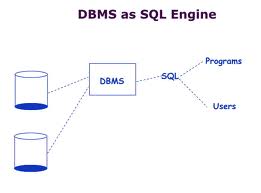Data is recorded facts and figures, and information is knowledge derived from data. A database stores data in such a way that information can be created.
2. What is Enterprise Resource Planning (ERP), and what kind of a database is used in an ERP application?
Enterprise Resource Planning (ERP) is an information system used in manufacturing companies and includes sales, inventory, production planning, purchasing and other business functions. An ERP system typically uses a multiuser database.
3. What is a DBMS?
DBMS stands for Database Management System. A DBMS receives requests from applications and translates those requests into actions on a specific database. A DBMS processes SQL statements or uses other functionality to create, process and administer databases.
4. Why is a database considered to be "self-describing"?
In addition to the users' data, a database contains a description of its own structure. This descriptive data is called "metadata."
5. Who is E.F. Codd, and why is he significant in the development of modern database systems?
While working at IBM, E.F. Codd created the relational database model. A paper he published in 1970 presented his ideas to the world at large. His work is the foundation for most of the DBMSs currently in use, and thus forms the basis for database systems as we know and use them today.
6. What is SQL, and why is it important?
SQL stands for Structured Query Language, and is the most important data processing language in use today. It is not a complete programming language like Java or C#, but a data sublanguage used for creating and processing database data and metadata. All DBMS products today use SQL.
7. Write an SQL SELECT statement to display all the columns of the STUDENT table but only those rows where the Grade column is greater than or equal to 90.
SELECT * FROM STUDENT WHERE Grade >= 90;
8. Name and briefly describe the five SQL built-in functions.
COUNT: computes the number of rows in a table. SUM: totals numeric columns. AVG: computes the average value. MAX: obtains the maximum value of a column in a table. MIN: obtains the minimum value of a column in a table.
9. Write an SQL SELECT statement to count the number of rows in STUDENT table and display the result with the label NumStudents.
SELECT COUNT(*) AS NumStudents FROM STUDENT;
10. What is an SQL subquery?
An SQL subquery is a means of querying two or more tables at the same time. The subquery itself is an SQL SELECT statement contained within the WHERE clause of another SQL SELECT statement, and separated by being enclosed in parenthesis. Some subqueries have equivalent SQL join structures, but correlated subqueries cannot be duplicated by a join..
11. Discuss the alternative terminology that is used in the relational model.
Relations are also called tables, and sometimes by the older data processing term files. A row is known as a tuple in the relational model, but may also be referred to as a record. Finally, relational model attributes are known as table columns and sometimes as fields.
12. Why are functional dependencies not equations?
Equations deal with numerical relationships. A functional dependency deals with the existence of a determinant relationship between attributes, regardless of whether or not there is a numerical relationship between them. Thus, if we know that there is no hot water every Wednesday, No-Hot-Water is functionally dependent on Wednesday. So, if we know it is Wednesday, then we know we will have No-Hot-Water. This is a functional dependency, but not an equation.















0 comments:
Post a Comment